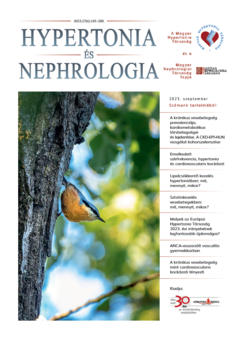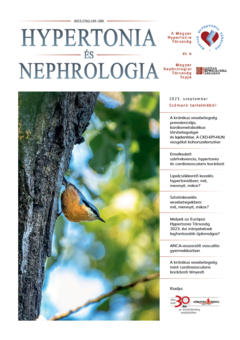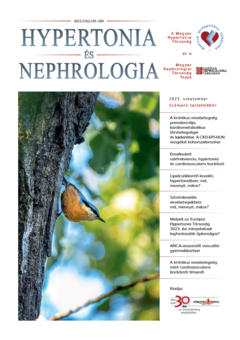The eLitMed.hu medical portal uses computer cookies for convenient operation. Detailed information can be found in the Cookie-policy.
Specialities
Nephrology
[Melyek az Európai Hypertonia Társaság 2023. évi irányelvének legfontosabb újdonságai?]
[Húsz évvel az Alberto Zanchetti vezetésével összeállított és a nemzetközi tudományos életben rendkívüli mértékben elismert, az orvosi területen mindmáig a legtöbbet idézett első európai hypertonia-irányelv publikálását követően, az Európai Hypertonia Társaság (European Society of Hypertension – ESH) 2023. évi kongresszusán, Milánóban mutatták be a társaság új, a hypertonia ellátását segítő vezérfonalát. Az irányelv a kongresszussal egy időben került online publikálásra (1), a végleges publikáció jelen összefoglaló megjelenésekor, reményeink szerint, már olvasható a Journal of Hypertension augusztusi számában. Ez az irányelv a korábbi kettő kiadástól eltérően, amikor is az Európai Kardiológus Társasággal (European Society of Cardiology – ESC) közösen került kiadásra, az ESH egyedüli gondozásában jelent meg. ]
[ANCA associated vasculitis in childhood]
[ANCA-associated vasculitis is a systemic autoimmune disease with a severe course and a high percentage of renal involvement. It is much more common in the adult population than in children, so there are few large case-control studies in pediatric population. We present case reports of six children treated for ANCA-associated vasculitis over the past five years. In addition to the case presentation, we will also discuss current immunosuppressive therapeutic options and the issue of plasmapheresis. We describe the initial symptoms and the time between the onset of symptoms and diagnosis. We present the initial laboratory data and a 12-month retrospective follow-up of renal function. We also describe the therapies used in our patients. Given the small number of cases, we do not aim to present detailed statistical conclusions.]
[Chronic kidney disease as cardiovascular risk factor]
[Chronic kidney disease (CKD) is one of the major risk factors for cardiovascular disease (CVD). More than 50% of patients with CKD die from CVD before starting dialysis. The relationship between CKD and CVD is explained by several mechanisms, including arterial stiffness, inflammation, oxidative stress, anaemia, calcium-phosphorus metabolism disorder and renin-angiotensin-aldosterone system activation. In order to reduce the cardiovascular risk of patients with CKD, it is important to recognize and treat CKD early, as well as to optimize the traditional and non-traditional risk factors. The aim of this review is to summarize the associations between CKD and CVDs, as well as the prevention and treatment options.]
[Beszámoló az Európai Hypertonia Társaság XXXII. kongresszusáról]
[2023. június 23–26. között Milánóban rendezték meg az Európai Hypertonia Társaság (European Society of Hypertension – ESH) XXXII. kongresszusát. A kongresszusra 958 absztraktot küldtek be, közülük nyolc Magyarországról származott. A kongresszus első napján, pénteken kora délután elsősorban az ESH különböző munkacsoportjai kaptak főtéma-lehetőséget, illetve a munkacsoportok közgyűléseire is ekkor került sor. Jómagam az ESH Working Group of Large Arteries-ének tagjaként ezen a szekción vettem részt, ahol szóba került az artériás érfalmerevség mérésének klinikai használatáról szóló, az év végéig tervezetten megjelenő konszenzusdokumentumának a helyzete. Ez az irányelv sokat segíthet a klinikusok számára a területet jelenleg övező számos bizonytalanság tisztázásában. Egy másik, a közeljövőben megjelenő közlemény a területhez köthető számos mérőeszköz validálásához is aktualizált iránymutatást fog nyújtani...]
[Who seeks, shall find often – deceptive recurrent pulmonary infiltrates]
[Pulmonary infiltrates can appear in many diseases. Instead of air, alveoli are filled by white blood cells, tumor cells, blood, pus, protein, etc., and result in athelectasia. Among all etiological factors of infiltrates, community-acquired pneumonia occurs most frequently, which is one of the leading causes of mortality and morbidity worldwide.
By definition, it is an infection through living pathogens, affecting the interstitium, alveolar space and terminal pulmonary airways. However, we often do not succeed to recognize the infectious agent in the background thus it may be presumed that the changes demonstrated by imaging modalities, albeit supported by the symptoms, do not present a pneumonia indeed.
This study concerns a case of a 58-year-old woman diagnosed with pneumonia and treated regularly by antibiotics. Although her condition temporarily improved, the complaints (asphyxiation, fever, weakness) returned regularly, her CRP levels were repeatedly elevated, and the chest CT scans showed bilateral pulmonary infiltration. Bronchoscopy samples were used for culture and lower respiratory PCR which with negative blood culture ruled out the pneumonia. Further tests and an immunological consultation verified ANCA-positive granulomatosis with polyangiitis behind her worsening condition.
This case study draws our attention to the importance of reporting recurrent pneumonia to a pulmonologist and demonstrates the significance of microbiological sampling and deep respiratory PCR in recognizing similar conditions. ]
[Hematopoietic abnormalities and coagulopathy in community acquired pneumonia associated sepsis]
[In patients with community acquired pneumonia associated sepsis, there are emerging frequently hematopoietic changes and disturbed haemostasis of varying severity as a part of the multiorgan dysfunctions. Between 2012 and 2020, we diagnosed community acquired pneumonia in 1826 patients. Among them, we recognised 218 cases of developing sepsis with typical symptoms and laboratory changes. In these septic patients, we registered the frequency and severity of anaemia, the quantitative and qualitative changes of leucocytes, the numerical abnormalities of platelets, and the pathologic haemostasis. The septic patients’ most frequent hematopoietic disorders were anaemia (n=159) and leucocytosis (n=151). Extremely severe leucocytosis (white blood cell count >50000/microlitre) was diagnosed in six patients. Decreased leucocyte count (leucopenia, agranulocytosis) was detected in 34 cases. There were three cases of leukemoid reaction: in prevalent leucocytosis we observed myelocytes, metamyelocytes and some atypical myeloid cells in the peripheral blood. In one patient crista biopsy was performed with Jamshidi technic, due to severe pancytopenia in the peripheral blood count. The histology of the crista biopsy revealed myelodysplastic bone marrow characteristics. In our patients with sepsis, concerning the number of platelets, the thrombocytopenia dominated (n=82). ]
1.
Clinical Neuroscience
[Headache registry in Szeged: Experiences regarding to migraine patients]2.
Clinical Neuroscience
[The new target population of stroke awareness campaign: Kindergarten students ]3.
Clinical Neuroscience
Is there any difference in mortality rates of atrial fibrillation detected before or after ischemic stroke?4.
Clinical Neuroscience
Factors influencing the level of stigma in Parkinson’s disease in western Turkey5.
Clinical Neuroscience
[The effects of demographic and clinical factors on the severity of poststroke aphasia]1.
2.
Clinical Oncology
[Pancreatic cancer: ESMO Clinical Practice Guideline for diagnosis, treatment and follow-up]3.
Clinical Oncology
[Pharmacovigilance landscape – Lessons from the past and opportunities for future]4.
5.








